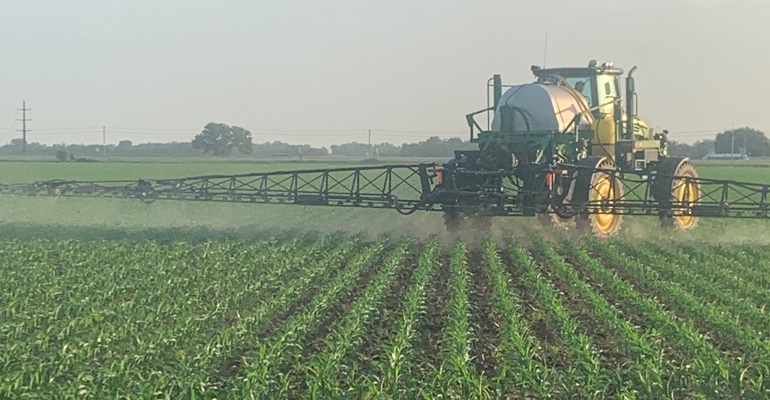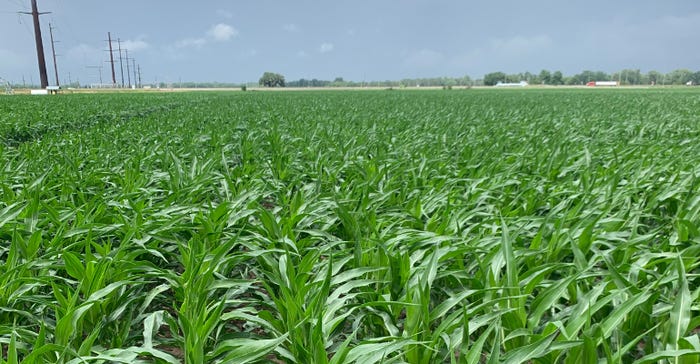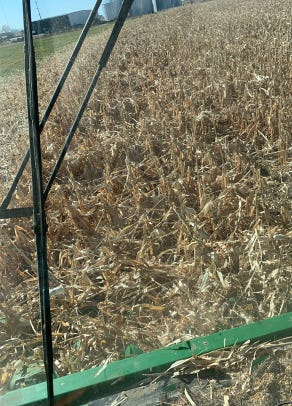
Brock and Cody Neville have grown up farming in western Sedgwick County, Kan. — first as children following their father around, learning the ins and outs of dealing with the blows of nature and markets.
When the brothers noticed that the full-season soybeans they planted in two of their fields just didn’t perform well, they started investigating the cause. What they learned was that the irrigation water they were using was high in salt content.
They had not noticed an impact on the corn they planted in rotation with wheat on those fields, and decided to embark on an experiment: planting corn as a double crop behind wheat.
“The big concern is getting that corn planted as immediately after wheat harvest as possible,” Brock says. “We made a decision that July 4 would be the absolute latest we’d plant. If we didn’t get it planted by then, we’d not plant at all.”
Their first year of the experiment was 2019. They got it planted on July 3 into standing wheat stubble.
 NEAR CANOPY: The field, planted with short-season Pioneer 0622AML, was very close to canopy on July 30. Brock said the crop was at full canopy just four days later. (Cody Neville)
NEAR CANOPY: The field, planted with short-season Pioneer 0622AML, was very close to canopy on July 30. Brock said the crop was at full canopy just four days later. (Cody Neville)

“We decided to plant narrow rows — 20 inches — and to up the seeding rate to 36,000 seeds per acre, and use a fixed-ear hybrid. We fertilized it like we would dryland and planned on two fungicide applications, one by ground and one with airplanes.”
The first year’s yield was 126 bushels per acre, behind a wheat harvest that was close to 100 bushels per acre, Brock says.
For 2020, the brothers modified their plan a bit in an attempt to get better emergence and control late-season disease.
Instead of planting into stubble, they burned the field, and then incorporated fertilizer with a vertical tillage tool. They planted on July 2 and chose short-season Pioneer 0622AML for their hybrid.
“It just leaped out of the ground,” Brock says. “It grew like crazy and canopied in 32 days.”
They treated the field three times, once with herbicide for weed control and fungicide, and twice with an aerial application of fungicide.
But 2020, a year filled with challenges, had one more for the enterprising brothers: a hard freeze following a light snowfall the third week of October.

UGLY HARVEST: An early freeze on Oct. 20 caught the corn before full maturity, but it was close enough to harvest for grain. This view from the combine shows the challenge the brothers faced at harvest a month later, on Nov. 19. Many stalks fell over, but thanks to narrow rows, most fell on an adjacent row, easing pickup. The field made 138 bushels to the acre. (Brock Neville)

“We were prepared to write this year off and just chop for silage after the freeze,” Cody says. “But we took a look with our Pioneer and Crop Quest agronomists, and they said we were half to three-quarters of milk line. They thought we would have some yield loss, as well as light-test-weight corn, but we could harvest grain.”
20-inch rows help after freeze
The days until November harvest showed a pretty ugly field — the freeze had killed the plants, and they began falling over.
“That was one place that the 20-inch rows really helped,” Brock says. The plants mostly fell onto the adjacent row, and we were able to pick it up pretty easily.”
When the numbers came in, they were pleasantly surprised.
The corn harvested at 138 bushels per acre, with an average test weight of 58 pounds. And that came behind a wheat yield of 106 bushels per acre, enough to win Brock and Cody Neville a third-place prize in the Kansas Wheat annual yield contest.
“Cody and I are really pushing the envelope with this experiment, but we’re going for it again next year. We planted the earliest-maturing wheat and hope to get it off quickly. Ideally, we’d like to get the corn planted around the second weekend of June. We try to do everything we can to minimize the risk, because you can’t get crop insurance on double-crop corn,” Brock says.
Most of the Neville brothers’ operation is more conventional farming rotations of corn, wheat and soybeans, but most of the operation is not challenged by water-quality issues.
“The fields we’ve been experimenting with are side by side and about 40 acres each,” Cody says. “It’s small enough to make pushing the envelope less risky overall. We’ll keep doing it and see what happens with other conditions. Every year is different. But overall, we’re pretty happy with 106 bushels of wheat and 138 bushels of corn. We can call that a success.”
About the Author(s)
You May Also Like






